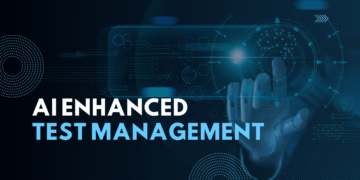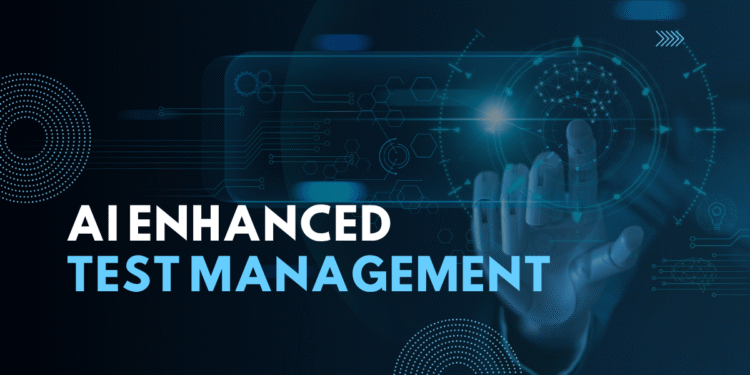An essential component of software development, test management guarantees that the application satisfies quality standards, is error-free, and operates as intended. Unfortunately, certain problems with traditional test management systems affect application speed and quality, leading to serious issues. Hence, the challenges of effectively managing testing procedures increase with software complexity. Artificial intelligence (AI) is essential to addressing the changing test management issues.
AI provides creative solutions to a lot of these problems. It is capable of analysing data, identifying potential risks, and concentrating on testing the most crucial areas by utilising intelligent algorithms. AI assists test management tools in prioritising test cases by concentrating on the most important aspects of an application by analysing large amounts of data sets and finding trends. This leads to improving the accuracy and efficiency of the testing process.
In this article, we will cover the role of AI-driven test management in enhancing test case prioritisation and risk analysis. A few challenges will also be covered while implementing AI in test management, with strong strategies that must be considered. So let’s quickly have a brief introduction to test case prioritisation and risk analysis in AI-driven test management.
AI-Driven Test Management For Smart Test Case Prioritization and Risk Analysis
Test management is an approach to ensure all steps and workflows are tested. It also involves managing and organising the process of testing software. Test cases are created, executed, and monitored under predetermined conditions to ensure that software functionalities meet all requirements. To increase efficiency and workflows and guarantee more robust software in the future, machine learning and artificial intelligence both play significant roles in test management.
AI solutions used in test management use intelligent algorithms to prioritise test cases based on risk, failure rates, and modification of scripts, ensuring that the most critical tests are executed first. It conducts the risk analysis through the detection of any issues in the project data. The result of this methodology is improved quality of software, faster time-to-market, and improved testing.
AI algorithms prioritise test cases based on data such as past failures and usage trends. It determines which test cases need to be run first in highly risky areas, including freshly altered code or modules that usually fail. AI performs risk analyses using natural language processing to find potential errors before they become major issues. In addition, machine learning can evaluate the probability and possible impact of various challenges.
Read Also: when did newport news clothing go out of business
How Does AI-driven Test Management Enhance Test Case Prioritization and Risk Analysis
Prioritising Dynamic Tests
AI intelligently modifies test priorities in contrast to conventional techniques in response to bug fixes, new code updates, and existing behaviour incorporations. This ensures that new or updated functionality is immediately tested.
ML for Continuous Improvement
Machine learning acquires information with each test cycle. With each iteration, they improve the accuracy and efficacy of prioritising by refining their predictions about which test cases are most likely to indicate errors.
Enhanced Test Coverage
AI may find flaws in existing test suites and create new test cases, including often-ignored edge scenarios, by analysing application requirements and user behaviour patterns. A huge amount of data may be analysed by AI to find areas that conventional testing might have overlooked. It may create test cases according to software specifications, guaranteeing a thorough analysis of each feature.
Predictive Analytics
Testing with AI is capable of anticipating possible flaws or weaknesses by using past data. Teams may handle problems before they arise due to this proactive strategy, which guarantees a more efficient development process.
Quicker Bug Detection
Testers no longer need to manually update faulty scripts every sprint; AI-enhanced test management tools can automatically correct them as they evolve. Real-time UI changes and API modifications are detected by them, and they adjust independently.
Cost-Effectiveness
Artificial Intelligence has the potential to significantly lower testing expenses by decreasing human intervention and mistakes. These savings might be used by organisations to invest in other creative endeavours.
Data-based Insights
AI is more than just a pass-or-fail proposition. Teams can learn more about the causes of test results and gain more insight into where the issue is occurring.
Intelligent risk analysis and management
AI uses variables like code updates, complexity, and historical defect data to automatically analyse the risk associated with different test scenarios. This lowers the cost of post-release bug fixes and enables testing efforts to prioritise high-risk regions, preventing major issues from reaching production.
Adaptive Learning
The AI models evolve and optimise their risk analysis and risk prioritisation techniques over time using feedback and test results. This adaptability guarantees that as the application evolves, the testing procedure will remain efficient.
Raed Also: TheHakevent: The Best Online Event
Challenges in Implementing AI in Test Management
- The quality of the data- The quality of the data used to train an AI system determines how well it works. This data must be reviewed because AI develops on it. AI will ultimately make judgments that do not match expectations if it is not appropriate or precise. It is necessary to conduct activities to evaluate the quality of their data and take the necessary actions to improve it. Strategies for creating and cleaning data can get rid of errors and duplicate data. To make sure the data is suggestive, it is also essential to confirm its usefulness in the real world.
- Transparency and interpretability of models- It can be difficult to design, construct, and train models that are accurate and interpretable on their own. Transparency and model complexity are not the same thing since more complex models are more difficult to understand.
- Expertise and knowledge- One difficulty is the lack of professionals who have a dedicated understanding of ML and AI technology. Organisations need to employ specialists in professional training and skill development to develop these skills.
Test Management Strategies to Implement AI for Test Case Prioritization and Risk Analysis
AI-powered risk analysis and test prioritisation is a cutting-edge approach of modern software development that enables teams to swiftly identify and execute the most important test cases. Let us explore a comprehensive instruction for implementing this strategy:
Estimate the Workflow for Existing Tests
To find bottlenecks, inefficiencies, and redundant test cases, begin by evaluating existing test procedures. A thorough analysis will show where they can benefit most from artificial intelligence.
Gather and Compile Historical Data
Important data is necessary for artificial intelligence to make informed conclusions. Collect previous test results, defect logs, code commit history, and variants to compile historical test data. In order to test deployment periods and outcomes, testers must evaluate metrics for performance. This data should be cleaned and streamlined to effectively train AI models. This ensures that the algorithms can identify trends and predict high-risk regions.
Choose the Right AI Tools for Testing
Choose AI-driven tools that support the existing testing environment. Consider solutions that offer features like risk-based prioritisation and error prediction using machine learning models. Also, look for integration with well-known CI/CD platforms.
Execute a Pilot Project
Start with a small, controlled pilot to confirm the tool’s efficacy. Focus on areas with more frequent defects or faster rates of development. Use this method to estimate the accuracy of test prioritisation and risk analysis, calculate the implementation reduction of time, and gather information to modify the tool for wider use.
Develop and Track Machine Learning Models
With constant learning, artificial intelligence develops over time. To increase its accuracy and adaptability, regularly add new testing and defect data. Analyse its performance to verify ongoing improvements.
Integrate the CI/CD Pipeline with AI
The CI/CD Pipeline should be integrated with the AI-powered system of test prioritisation. This makes tests accurate and relevant as the tool can dynamically configure tests in real-time as a result of code changes.
Collaborate Between Humans and AI
Instead of replacing human testers, encourage AI to be employed in addition to them. Making strategic decisions, analysing AI perspectives, and managing complicated and unexpected issues all require human judgment.
Invest in Data Governance and Quality
High-quality, relevant data is essential to AI models. This includes historical test results, bug reports, script modifications, and user behaviour. To avoid inaccurate results, develop strong data governance and ensure that data is reliable and clean.
The Future of AI-Enhanced Test Management
The test case process can be greatly optimised and streamlined with the use of AI and ML in test case management. Organisations may automate the case generation process, prioritise test executions according to risk factors, and obtain the necessary insights to enhance the quality of software in the future by utilising the pertinent AI algorithms.
Automated test case generation
Testing existing code and behaviour patterns will be one of AI’s most significant benefits. Once executed, it can easily build new scenarios and lead to conclusions from historical test results. This can help human testers focus on more crucial tasks that may seem challenging. One such platform that is influencing the direction of AI-driven test management is LambdaTest.
It offers an AI Test Case Generator that accepts various input formats, plain text, PDF documents, images, audio/video recordings, spreadsheets, or even direct links to issue-tracking tickets (like from Jira or Azure DevOps) – and transforms them into structured test cases.
After inputting requirements, the system analyzes them, identifies scenarios and edge cases, and groups related test cases into logical “scenarios” (for example, labelled “Must have,” “Should have,” “Edge”). Each test case includes a title, description, pre-conditions, steps and expected outcomes.
Once generated, these test cases can be edited, refined and selected for inclusion in your test repository. They are fully editable, so QA teams can customise them to match specific needs or standards.
The tool integrates with automation workflows: the test cases generated via the AI engine can be used for both manual and automated testing. They also support linking automated test runs to test cases in Test Manager for traceability.
The benefits: it saves manual effort in writing test cases from scratch, improves test coverage by catching scenarios that might otherwise be missed, and brings more consistency and speed into test planning.
Additionally, the platform speeds up issue resolution and eliminates assumptions by enabling testers to quickly classify faults and giving them direct access to suggested fixes. Teams may monitor abnormalities and make smarter decisions on complicated testing scenarios with the help of the test intelligence tool, which offers actionable insights from test runs. SmartUI is used by LambdaTest AI to evaluate software versions and identify visual differences between environments.
Self-healing automated tests
Automation frameworks can adjust and self-heal in response to modifications. To save expenditures and increase dependability, these ML algorithms will also be able to update test data and scripts.
Test data Optimization
AI models can be used to generate code modifications, optimise test data from historical data, and identify fault patterns. With higher accuracy, they can also optimise coverage and prioritise test cases.
Conclusion
In conclusion, using conventional techniques for test management can be complicated. However, AI provides creative solutions to a lot of its underlying problems. Machine learning, predictive analytics, and natural language processing are some of the techniques used by AI-based test management solutions. These methods deal with common test management deficiencies. They assist in enhancing the effectiveness, efficiency as well and reliability of their tests.
AI-driven solutions can completely transform the software testing process, from test case prioritisation to test management. AI has the potential to create better applications with quicker release cycles. AI’s contribution to test management will only grow in importance as it develops further, enabling organisations to satisfy user needs and thrive in a competitive software industry.
Read Also: Isotonix Lawsuit Explained: Legal Issues FDA Warnings









































